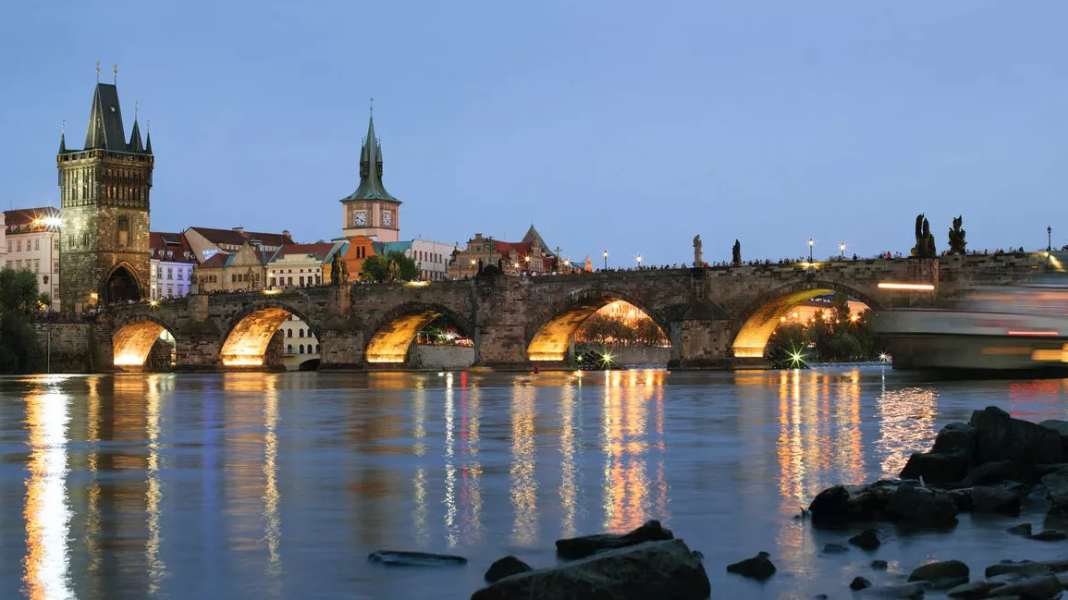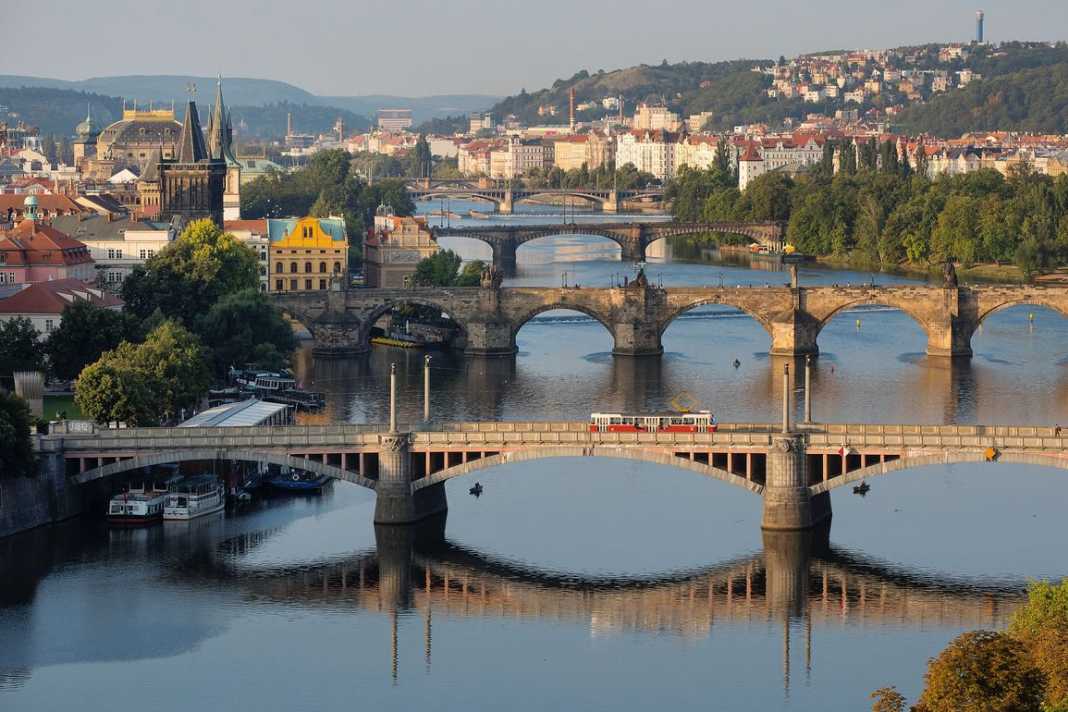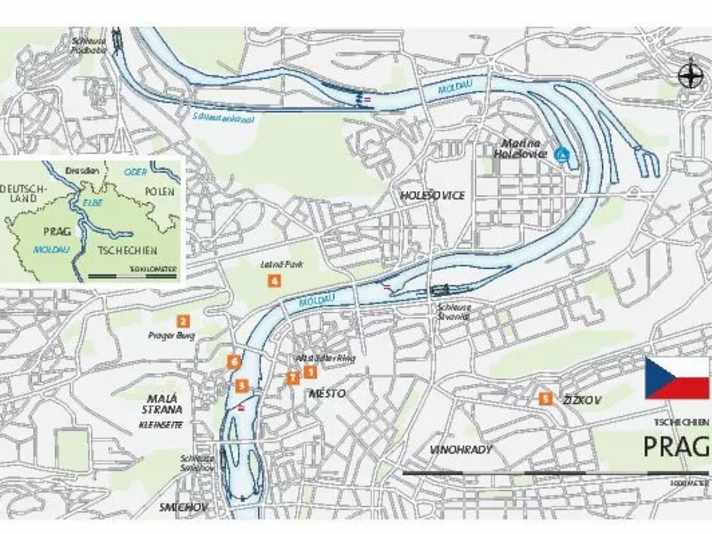
After the "Velvet Revolution" in 1989, the Golden City awoke from its communist slumber and developed from an insider tip into a place of longing for countless tourists from all over the world. Intoxicated by the mix of styles from different eras, the sounds of Smetana's "Vltava" (and cheap top-quality beer), thousands of visitors wander through the historic streets every day. But the historic capital of the Czech Republic has even more to offer - and those travelling by pleasure boat not only have a beautiful route, but also an urban dream finale to their destination.
The journey takes you along the Elbe via Magdeburg, Dresden and the Elbe Sandstone Mountains to Melnik in the Czech Republic, where the Vltava flows into the Elbe at kilometre 837. Shortly before the mouth of the Vltava, however, you have to turn onto the ten kilometre long Vltava Canal, which bypasses an impassable weir in Vranany on the Vltava. The Horin lock at the beginning of the canal is an impressive hydraulic engineering monument and looks like an old fortress with its towers. At kilometre 20 on the Vltava, the Marina Vltava is not only a good place to spend the night, but also an attractive restaurant with a terrace overlooking the river.
Impressions from Prague:






After two more locks, the extensive urban area of Prague finally begins at kilometre 41. The HoleŠovice marina at kilometre 47.4 (with brewery) is an ideal place to safely moor the boat. A sightseeing tour on your own keel is highly recommended in the early hours of the morning, when the many excursion boats are not yet busy in the city locks and Prague city centre. Incidentally, we recommend travelling outside the summer months to avoid the low water levels on the Elbe ( www.elwis.de ).
The border with the Czech Republic can be crossed by boat without any problems due to the Schengen Agreement. It is not necessary to clear in or out.
Hotspots in Prague:

1st Old Town Square (Staroměstské náměstí)
Once the social centre of the city, the former market square is now the tourist centre of Prague. The Old Town Hall offers visitors a beautiful view from the top of the tower, while the Astronomical Clock dating back to 1410 delights the crowds with a medieval show every hour on the hour.
2nd Prague Castle (Pražský hrad)
Together with the Gothic St Vitus Cathedral, it impressively dominates the left bank of the Vltava. In addition to royal coronations and presidential swearing-in ceremonies, the castle has always been the scene of historical turning points. The second Defenestration of Prague in 1618 triggered the Thirty Years' War, while the civil rights activist and writer Václav Havel defeated the communist regime in 1989 and rose from imprisoned enemy of the state to acclaimed president within a year. A few hours should be planned for a visit to the largest castle grounds in the world. Highlights include the pompous changing of the guard at 12 noon in the First Courtyard, the Vladislav Hall in the Old Royal Palace and the valuable art collections in the Castle Gallery. You can relax in one of the castle cafés or in the Kleinseitner Gardens.
3. Charles Bridge (Karlův most)
Construction of the bridge began in 1357 by order of Charles IV, the then Holy Roman Emperor. It connects Prague's Old Town and the Malá Strana Lesser Town. It is the oldest preserved bridge over the Vltava and one of the oldest stone bridges in Europe. Every day, thousands of tourists cross the bridge, which is adorned with Madonnas and statues of Catholic saints and enlivened by small artists. It is the beating heart of Prague. The view of the Vltava and the neighbouring districts is unique at any time of day. Early in the morning - when the city and its visitors are still asleep - you can capture very special moments and moods.
Every year on 15 May, the pompous "Navalis" St John's Festival takes place on the water around the bridge. Baroque music, fireworks, processions and regattas are held in honour of St. John of Nepomuk, the patron saint of bridges and gondoliers. In addition to many other pilgrims, Venetian gondoliers also come to Prague every year to honour their patron saint. Café Marnice is located under the spur of the Charles Bridge and two shady chestnut trees. In the lee of the crowds, you can recharge your batteries with Prague goulash and a large Budweiser pilsner before exploring the small town and the idyllic Vltava island of Kampa.
4th Prague Metronome (in Letná Park)
Skaters have perhaps the best view of the city's bridges from the Prague Metronome in Letná Park, which was built on the base of the Stalin monument that was blown up in 1962. Only a few tourists get lost here. The best time to go up is again early in the morning. With a small breakfast pack, you can enjoy the view twice over and have the perfect light for an atmospheric photo.
5. Žižkov
Just east of the old town is Žižkov, the alternative working-class and student neighbourhood with countless pubs and bars. Unlike in the old town, you will mostly meet local revellers here. At 216 metres high, the futuristic TV tower is the tallest building in Prague and is home to the top restaurant Oblaca as well as a viewing observatory with a wonderful view of the city. If you like the morbid charm of cemeteries, we recommend a visit to the Olsany cemeteries. The largest burial ground in Prague holds the remains of more than two million deceased people, including Franz Kafka.
6th Franz Kafka Museum
One of the city's most famous sons is the Jewish writer Franz Kafka (1883 to 1924, "The Trial"), who came from Prague's German-speaking minority. A visit to the Franz Kafka Museum is particularly worthwhile for German-speaking visitors. The museum is located on the Lesser Town bank of the Vltava River within walking distance of Charles Bridge. www.kafkamuseum.cz
7th Absintherie (Franz Kafka Square/Náměstí Franze Kafky)
An original alternative to the many beer bars is the small Absintherie on Franz-Kafka-Platz. Here, everything on offer is dedicated to the cult drink from the 19th century. With 100 different flavours to choose from, the informative staff celebrate every preparation. But beware: the drinks are high in alcohol and can have a Kafkaesque effect on your senses!
Distances
Elbe
- Magdeburg-Dresden: 270 km
- Dresden-German-Czech border: 50 km
- German-Czech border-Melnik: 107 km
Vltava Canal
- Melnik-Vranany: 10 km
Moldova
- Vranany-Prague, Marina HoleŠovice: 47.4 km
- Prague, Marina HoleŠovice-Prague, Charles Bridge: 5.6 km

